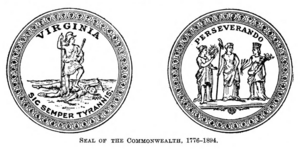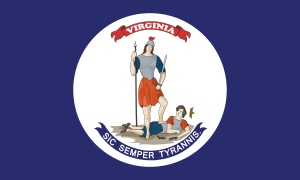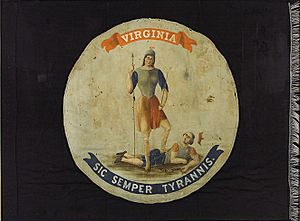Flag and seal of Virginia facts for kids
The Seal of the Commonwealth of Virginia is the official symbol of Virginia, a U.S. state. It's like a special stamp that shows what Virginia stands for. The state flag of Virginia uses the front side of this seal on a blue background.
Virginia first adopted its state flag during the American Civil War in April 1861. It was adopted again in 1912 and made official in 1950. The flag shows a strong female figure named Virtue. She has defeated Tyranny, who is shown as a fallen king. The Latin words "Sic semper tyrannis" are on the seal. This means "Thus always to tyrants." Sometimes, the flag has a white fringe on the edge, especially when it's displayed indoors.
Contents
History of Virginia's Symbols
In May 1776, the Virginia colony declared its independence from Great Britain. This was a big step! On July 1, 1776, a group of four important people was chosen. Their job was to create a special seal for the new Commonwealth of Virginia.
The four men were Richard Henry Lee, George Mason, George Wythe, and Robert Carter Nicholas. Just four days later, their design for the seal was ready. George Mason showed it to the Virginia government. Everyone voted and approved it on the same day. We don't know for sure who designed most of the seal. But many believe George Wythe did most of the work.
The people who designed the seal did not want it to look like British symbols. They really admired the Roman Republic. So, they chose a design inspired by Ancient Rome and its myths. They also decided to make the seal two-sided, with a front and a back.
Understanding the Seal's Design
The Front Side (Obverse)
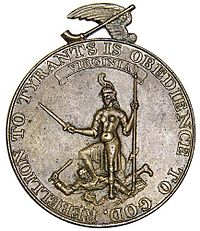
The front side, or obverse, of the seal is the official symbol of Virginia. It appears on all important papers and documents from the state government. It's also the main part of Virginia's flag.
On this side, you see a female figure. She represents a Roman idea called Virtus, which means "virtue" or "courage." She stands for the spirit of the new Commonwealth. Virginia's Virtus looks peaceful, showing that a battle has already been won. She leans on a long spear, with its point facing down. This shows peace. Her other weapon, a small parazonium (a type of sword), is put away. It's a symbol of authority, not fighting.
Under Virtus's foot lies Tyranny. This figure represents Great Britain and its defeat by Virginia. A royal crown has fallen to the ground next to him. This shows that the new republic is free from the king's rule. Virginia and New York are the only U.S. states with a crown on their flag or seal.
Tyranny's left hand holds a broken chain. This symbolizes Virginia's freedom from Britain's rules on trade and expanding westward. The useless whip in his right hand shows Virginia is free from harsh acts of punishment. His purple robe is a nod to ancient Roman rulers.
The words chosen for the front of the Virginia seal are Sic semper tyrannis. In English, this means Thus always to tyrants. This famous saying comes from Roman history. It is said to have been spoken by Brutus when he was involved in the killing of Julius Caesar. Caesar had been named a "perpetual dictator," and some senators worried he wanted to become a king and end the Roman Republic.
The Back Side (Reverse)
The reverse, or back side, of the seal shows the good things that come from freedom and peace. Three Roman goddesses are pictured here.
In the middle is Libertas, the goddess of individual freedom. She holds a wand with a Phrygian Cap on top. This cap is also called a Liberty Cap and became popular later with French revolutionaries.
To the left of Libertas is Ceres. She is the Roman goddess of agriculture (farming). In her left hand, she holds a horn of plenty. It overflows with the rich harvests of Virginia. In her right hand, she holds a large stalk of wheat. Wheat was one of Virginia's most important crops.
Aeternitas, representing Virginia's eternity, stands to the right of Libertas. In her right hand, she holds a golden ball, a symbol of authority. On top of the ball is a Phoenix, a mythical bird that symbolizes immortality. On the Virginia seal, the phoenix represents good government.
The words on the back of the seal are Perseverando. In English, this means Persevering. It reminds future generations to keep working hard to protect their liberty. The decorative border around both sides of the seal is made of Parthenocissus quinquefolia, also known as Virginia Creeper.
In 1930, a new group was formed to make the seal's design consistent. This was because many different versions had appeared over the years. The seals on the doors of the Capitol building in Richmond were designed by Charles Keck. The committee decided to use the original 1776 seal as the standard. In 1949, Virginia's Art Commission set the official colors for the seal.
The Great Seal and the lesser seal are almost the same, just different in size. The lesser seal is used for official papers that stay within Virginia's borders.
Official Description of the Seal
| Seal of the Commonwealth of Virginia | |
|---|---|
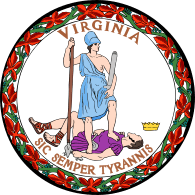
The seal of the Commonwealth of Virginia.
|
|
| Versions | |
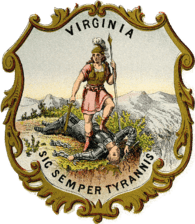
An illustration of the Virginia state historical coat of arms from 1876.
|
|
| Armiger | Commonwealth of Virginia |
| Adopted | February 1, 1950 |
The official description of the Seal of Virginia is found in the Code of Virginia (1950), Section 1-500. It says the great seal has two metal discs, about 2.25 inches wide. They have a border about 0.25 inches wide. The images and words on them are described like this:
- On the front (obverse): Virtus, the spirit of Virginia, is dressed like an Amazon. She rests her right hand on a spear, pointing down. In her left hand, she holds a sheathed sword, pointing up. Her head is straight, and her face looks up. Her left foot is on Tyranny, a man lying down. His head is to her left, with his fallen crown nearby. He has a broken chain in his left hand and a whip in his right. Above them, the word "Virginia" is written. Below, on a curved line, is the motto, "Sic Semper Tyrannis."
- On the back (reverse): There is a group of figures. Libertas holds a wand and a cap in her right hand. To her right is Aeternitas, holding a globe and a phoenix. To Libertas's left is Ceres, holding a horn of plenty in her left hand and an ear of wheat in her right. Above this group, on a curved line, is the word "Perseverando."
In Virginia, the Secretary of the Commonwealth is in charge of keeping the state's seals safe.
Images for kids



